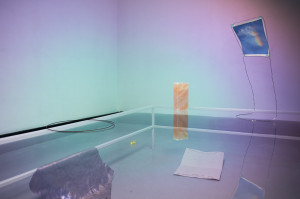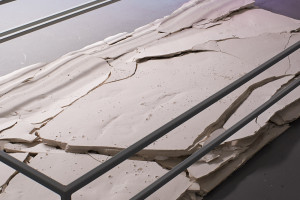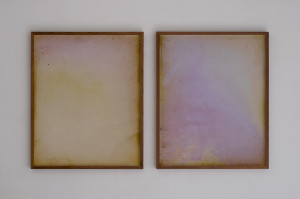Isobel Philip visits Conquest of The Useless, a one-night-only exhibition in which artists take on a Greek myth [no not that one]…
Open for one night on Friday 6 December at Sydney Guild, and by appointment during the following week, Conquest of the Useless was a short-lived affair that has continued to resonate with those who had the opportunity to see it. A collaboration between the artists KK+JLD (Kailana Sommer and Jack Dunbar) and the curatorial collective SuperKaleidoscope (Sarah Mosca and Kim Fasher), the exhibition enlisted the ancient Greek myth of Sisyphus as a conceptual proposition. In this myth, the tragic protagonist is condemned to a life of cyclical repetition. Punished by the Gods for his deceitfulness, Sisyphus is trapped in a loop of unproductive labour; he rolls a boulder up a hill but can never reach the top. The boulder rolls back down, the work begins again, ambition and failure entangled in the same gesture.
Within the context of the show, our encounter with the plight of Sisyphus was mediated by Albert Camus’ 1942 essay The Myth of Sisyphus that treats the mythological narrative as an allegory for the absurdist tragedy of the human condition. Seeking meaning, we find chaos. Yet out of this, Camus maintains, an awareness of the struggle – and the void in which we toil – is in some way liberating. The transcript of a telegram containing extracts from Camus’ essay greeted visitors at the door.
There is no more dreadful punishment -(STOP)- than futile and hopeless labor -(STOP)- Sisyphus is the absurd hero -(STOP)- the whole being -(STOP)- exerted toward accomplishing nothing -(STOP)- the cheek tight against the stone -(STOP)- at the very end of his long effort -(STOP)- measured by skyless space and time without depth -(STOP)- the purpose is achieved -(STOP)- it is during that return -(STOP)- that pause -(STOP)- that Sisyphus interests me -(STOP)- that is the hour of consciousness -(STOP)- he is superior to his fate -(STOP)- He is stronger than his rock -(STOP)- the absurd man, when he contemplates his torment, silences all the idols -(STOP)- Each atom of that stone -(STOP)- each mineral flake of that night filled mountain -(STOP)- in itself forms a world -(STOP)- the struggle itself toward the heights -(STOP)- is enough to fill a man’s heart -(STOP)- One must imagine Sisyphus happy -(STOP)-
Why the telegram? With its splintered fragments – its ‘stops’ and starts – why was this text a more appropriate preface than the essay itself? What is it about the heavy-handed, blunt pauses of the telegram that spoke to the networked installation of objects and images assembled in the space?
In the centre of the room, two steel frames for low-lying tables stood side by side. One was covered in a sheet of Plexiglass while a slab of shattered plaster rested at the base of the other, a collapsed tabletop transformed into a cracked, reclining monolith. Its dense mass and stagnant form served as a counterpoint to the large print of a cloud filled sky stretched across an aluminium frame and propped up against an adjacent wall.
Sisyphean micro-narratives unfolded between these tables. While one structure was nothing more than a voided empty frame, the other accommodated a collection of small sculptures and objects. Arranged on (and under) the one functioning table was a wire circle, a draped sheet of lead, a slab of wax resting atop one of the man-made rocks strewn across train tracks, a candle, a salt brick, a camera obscura made out of cardboard (while a photograph taken using the camera hung on another wall), a picture of a rainbow, a level (like the one you get from Bunnings) and, for a little while at least, a snail.
These objects, each loaded with metaphoric intent, were thematic plot points in this discrete restaging of Sisyphus’ journey. There was the circular void – a loose cipher for Sisyphus’ cyclical struggle, the wax slab propped up by a fake boulder that threatened to collapse (the candle burning beneath it adding to the drama), the level that was off-centre despite the fact that it was resting on a (seemingly) flat surface – haunted, perhaps, by the ghost of the Sisyphean incline – and the rainbow, that deceptive tease that promises a pot of gold but never delivers the goods. Sisyphus couldn’t get to the top of his mountain; you can’t find the end of a rainbow.
There were other rainbows and shards of light strewn throughout the installation. Cellophane stretched across the fluorescent lights that had been pulled down from the ceiling spilt coloured light across one wall. Its dance became an echo of the patterns produced by the camera obscura. In this photograph there is another light spill, another refraction.
The trails left by the snail on the transparent tabletop outlived the snail itself. These residual tracks were not the only records of past expeditions. Several other image-based travelogues appeared throughout the show. Two abstract photographs by Sarah Mosca, one half of the curatorial team, hung side by side on one wall. To produce each of these images, Mosca taped a single sheet of colour photographic film to her chest before setting out on long walk. With this act, Mosca extended the duration of the photographic ‘shot’ to the length of time she spent on her journey. Over exposed and illegible, these photographs are records of a cyclical gesture. They bear witness to a departure and a return – the start of the walk and its end – but also to the rise and fall of the artist’s breath. Taped to Mosca’s chest, the negative is touched by the movement of her inhale and exhale. This is another loop; a rise and fall like the gesture that bound Sisyphus to his fate.
Low to the ground and next to the tables, a projector screened looped archival footage from Captain Robert Falcon Scott’s 1912 expedition to the South Pole. Upon reaching their destination, the British explores realized the Norwegians had arrived first. On the return journey, their hopes of glory shattered, all in the party perished.
The footage of five men and a few horses plunging head on into a white expanse of empty space provides a cogent allegorical reference point for Camus’ absurd hero, toiling away in a ‘skyless space and time without depth’. Here, the void – that faithful absurdist trope – makes another appearance. In the empty white space of the Antarctic, every gesture becomes repetitive. They trudge on through the snow, the video loops: up the mountain and down the mountain, inhale and exhale, departure and return.
And so we are back to where we started: the telegram. Camus talks of the pause during which Sisyphus is happy, enlightened even. A moment of hesitation before the cycle begins again. A –(STOP)–. In Conquest of the Useless, that stop was given room to breathe.
Conquest of the Useless
KK+JLD & SuperKaleidoscope
Sydney Guild, Friday 6 December 2013



